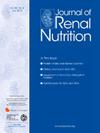Nutritional Intake and Diet Quality in Hemodialysis Patients: Scope for Improvement
IF 3.2
3区 医学
Q2 NUTRITION & DIETETICS
引用次数: 0
Abstract
Objective
Hemodialysis (HD) patients face challenges in upholding dietary compliance. This study aimed to compare dietary intake against disease-specific guidelines. Secondary, to assess the overall diet quality and to explore the association between dietary potassium intake and serum potassium concentrations.
Methods
In this cross-sectional multicenter study, nutrient intake of Dutch adult HD patients was assessed using food frequency questionnaires and diet quality with the Dutch Healthy Diet 15-index. Intake and diet quality were compared to disease-specific dietary recommendations or Dutch Dietary Guidelines. Insufficient intake was defined as <90% of the requirement, sufficient as 90-100%, and excessive as >110%. The association between serum potassium concentration and dietary potassium intake was modeled with linear regression analysis.
Results
The study population consisted of 248 participants (60% male) from 21 dialysis centers. Energy intake (1789 [872] kcal/day) was insufficient for 45% of the participants, while protein intake (1 [0.5] g/kg/d) was insufficient for 50%. Despite 67% of participants managing to align their energy intake below 110% of the recommended level, a high prevalence of overweight (61%) was observed in this cohort. Saturated fat intake was excessive for 87% of participants, while only 15% met the recommended fiber intake. Overall diet quality was low (74 [20] maximum score of 150). No association was observed between serum potassium and dietary potassium intake after adjusting for relevant confounders (r = 0.163, P = .261).
Conclusions
A considerable proportion of Dutch HD patients were unable to meet disease-specific dietary guidelines. Diet quality was shown to be poor.
血液透析患者的营养摄入和饮食质量:有待改善的范围。
目的:血液透析(HD)患者在维持饮食依从性方面面临挑战。这项研究的目的是比较饮食摄入量和疾病特异性指南。其次,评估整体饮食质量,探讨膳食钾摄入量与血清钾浓度之间的关系。方法:在本横断面多中心研究中,采用食物频率问卷(FFQs)评估荷兰成年HD患者的营养摄入,并采用荷兰健康饮食15指数(DHD15-index)评估饮食质量。将摄入量和饮食质量与疾病特定饮食建议或荷兰饮食指南进行比较。摄入不足的定义为110%。血清钾浓度与饲粮钾摄入量之间的关系采用线性回归分析。结果:研究人群包括来自21个透析中心的248名参与者(60%为男性)。45%的参与者能量摄入(1789[872]千卡/天)不足,50%的参与者蛋白质摄入(1[0.5]克/公斤/天)不足。尽管67%的参与者设法将他们的能量摄入控制在推荐水平的110%以下,但在该队列中观察到超重的高患病率(61%)。87%的参与者饱和脂肪摄入量过高,而只有15%的参与者达到了建议的纤维摄入量。总体饮食质量较低(74桶,最高得分为150)。校正相关混杂因素后,血清钾和膳食钾摄入量之间无相关性(r= 0.163, P= 0.261)。结论:相当比例的荷兰HD患者无法满足特定疾病的饮食指南。饮食质量很差。
本文章由计算机程序翻译,如有差异,请以英文原文为准。
求助全文
约1分钟内获得全文
求助全文
来源期刊

Journal of Renal Nutrition
医学-泌尿学与肾脏学
CiteScore
5.70
自引率
12.50%
发文量
146
审稿时长
6.7 weeks
期刊介绍:
The Journal of Renal Nutrition is devoted exclusively to renal nutrition science and renal dietetics. Its content is appropriate for nutritionists, physicians and researchers working in nephrology. Each issue contains a state-of-the-art review, original research, articles on the clinical management and education of patients, a current literature review, and nutritional analysis of food products that have clinical relevance.
 求助内容:
求助内容: 应助结果提醒方式:
应助结果提醒方式:


